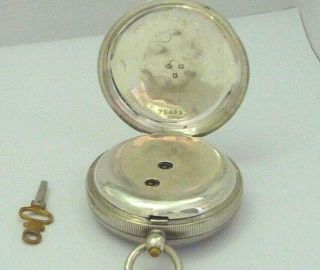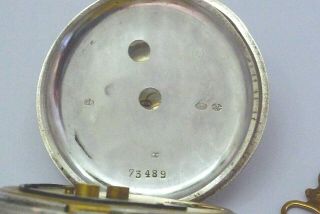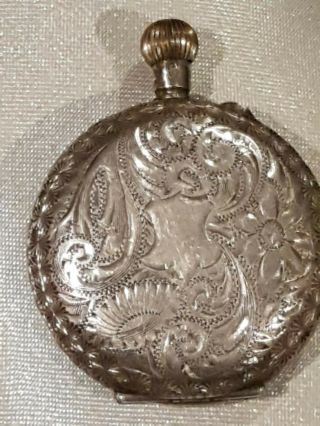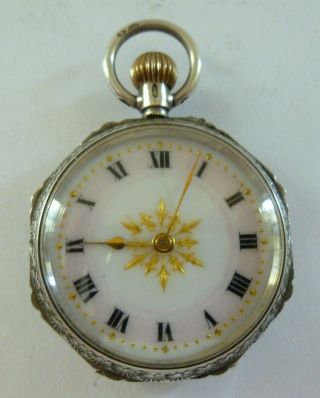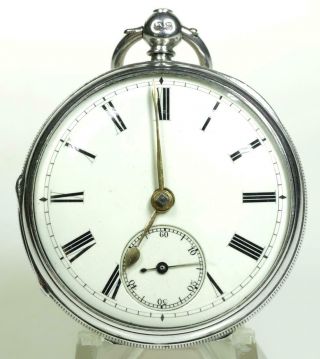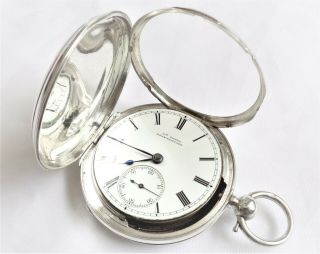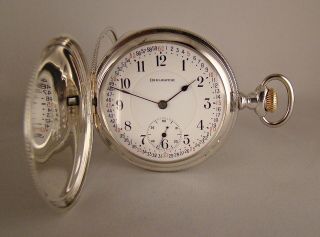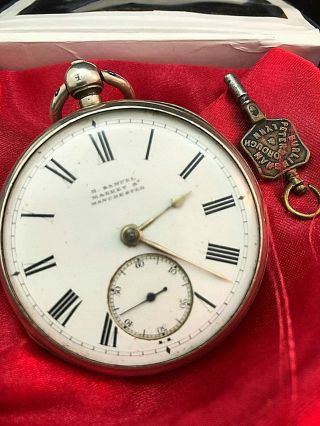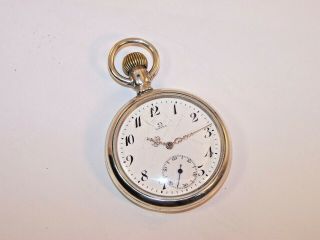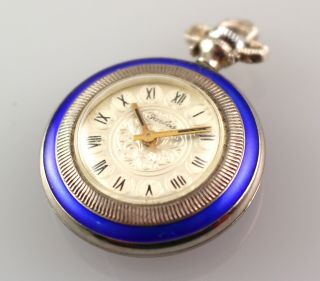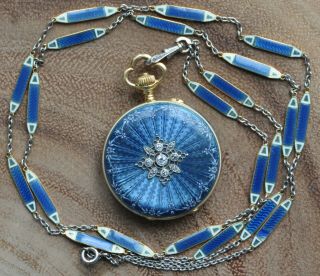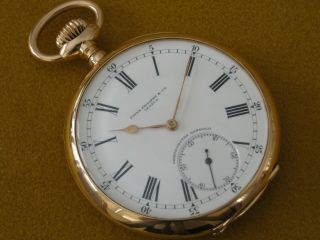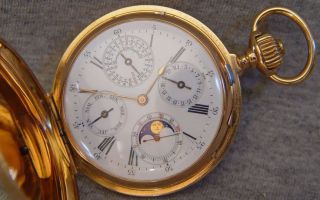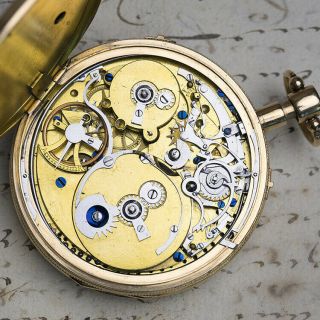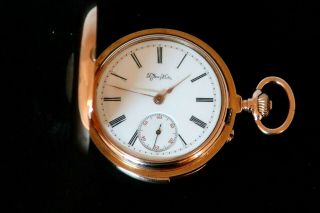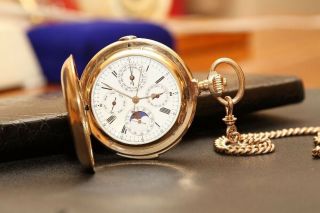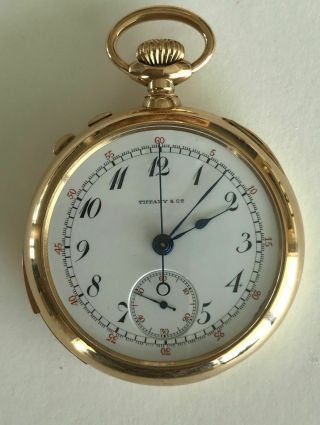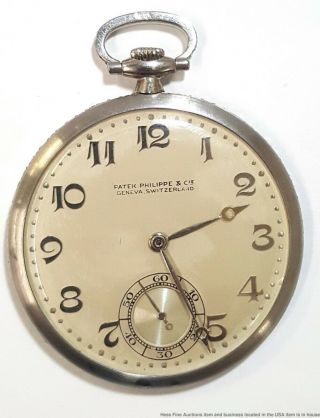STERLING SILVER GS STOCKWELL & COMPANY POCKET WATCH CASE OPEN FACE KEY WIND
Item History & Price
| Reference Number: Avaluer:37776126 | Department: Men |
| Vintage: Yes | Case Color: Silver |
| Closure: Open Face | Case Material: Sterling Silver |
| Brand: GS: Stockwell & Company | Type: Pocket Watch |
GS: Stockwell & CompanyStockwell & Company were carriers and shipping agents with their head office at 16 to 18 Finsbury Street, London, with many depots around the UK. They were part of a European wide network of shipping agents called Messageries Nationales. Stockwell & Company company was founded in the nineteenth century and became a large and company moving good around Britain and, through Messageries Nationales, across the continent. They were used by many Swiss watch manufacturers to transport watches from Switzerland to Britain.In 1907 the British law changed to require that all imported gold and silver watch case be assayed and hallmarked. Many Swiss manufacturers did not have offices in Britain and could not organise this themselves, so Stockwell & Company registered with several assay offices in order to submit items for hallmarking on behalf of their customers. Stockwell & Company did not own the goods, so they were not importers in the strict sense of the word but acted as “Assay Agents” for their customers.Stockwell & Company were not manufacturers and never made watch cases, or assembled, imported or sold watches. Stockwell and Company were carriers who acted as British assay agents for Swiss case makers. Watches are often advertised with the description saying something like this example; The movement is Swiss and the case is silver, the watch was assembled and made by George Stockwell for Stockwell and Co Ltd in 1914. This error is caused by the mistake of calling the sponsor's mark a “maker's mark” leading to the false assumption that it identifies who made an item. Watch cases made in Switzerland were stamped with Stockwell & Company's registered sponsor's mark before transported to Britain and sent to an assay office to be hallmarked and then returned to their makers in Switzerland.Origins of Stockwell & CompanyStockwell & Company was founded in 1878 by Henry Stockwell. In 1900 the firm was incorporated as a limited liability company Stockwell & Co. Ltd. George Stockwell was a nephew of Henry Stockwell. George had over twelve years experience when he succeeded Henry Stockwell to the management of the company.Stockwell & Company were the sole agent for Great Britain for the Messageries Nationales, the leading network of continental carriers with representatives in almost every European country.Kelly's Post Office London Directory for 1882 lists Henry Stockwell as agent for Messageries Nationales de France at 15 King St. The Business Directory of London for 1884, published by Morris, records Henry Stockwell as a shipping agent at 15 King St, Cheapside, London EC. The Post Office London Trades Directory for 1891 lists Messageries Nationales Limited, 15 King Street, Cheapside EC.Kelly's Post Office London Directory for 1910 lists "Messageries Nationales, shipping & forwarding agents (George Stockwell, manager), 16 & 18 Finsbury st EC (TA "Messageries" ; TN 6134 London Wall); 15 King street, Cheapside EC (TN 5487 London Wall) & 8 & 10 Beak st. Regent st W - TN 1721 Gerrard". Note the inclusion of telephone numbers, shown by TN and the number and district to be quoted to the telephone switchboard operator.Stockwell were part of a continent wide network of shipping agents including Messageries Nationales Express and the Messageries Anglo-Suisses, the Swiss end operated by Danzas & Co. of Basel under convention with the Swiss Federal Post. Louis Danzas had fought at Waterloo on the side of Napoleon. After the battle he joined a transport company which he eventually came to head. The Danzas company was acquired in 2000 by Deutsche Post World Net and is now part of DHL Global Forwarding. The Danzas name was dropped in 2005, which seems rather a shame for a company that could trace its history back to the battle of Waterloo.Stockwell & Company Assay AgentsWhen the British law regarding foreign watch cases was amended so that from 1 June 1907 all imported foreign gold and silver watch cases had to be assayed and hallmarked in a British assay office, many importers of foreign gold and silver did not have offices in Britain that could organise this so Stockwell & Company registered with several assay offices in order that they could arrange for their customer's watch cases to be hallmarked.George Stockwell's sponsor's mark was first registered with the London Assay Office on 15 June 1907, following the 1907 Act "Assay of Imported Watch-Cases (Existing Stocks Exemption)" which came into force on 1 June 1907, requiring all imported gold and silver watch cases to be assayed and hallmarked in a British assay office. George Stockwell also registered punches with the Birmingham Assay Office on 8 November 1917, and with the Glasgow Assay Office, although the date of registration in Glasgow is not recorded.Before 1 June 1907 it was possible for watches to be sent direct from suppliers in Switzerland to customers in the UK, but after 1 June 1907 the requirement for watches to be hallmarked in the UK complicated things.The assay offices would only accept empty watch cases for hallmarking, and after hallmarking the cases required at least final polishing. In order for a watch case imported as part of a complete watch to be sent for assay, a person or company with a "registered mark" had to remove the movement from the case and stamp the case with his registered mark. The watch case could then be sent to the assay office, where it would be tested (assayed) and if found to be of the proper standard it would be hallmarked and returned to be reunited with its movement. Obviously this required a premises where the movements could be removed and stored while the cases were being assayed, and staff to remove the movements and replace them once the cases were hallmarked. Some of the larger Swiss companies already had permanent agents in the UK and these were able to process watches for hallmarking, but many smaller Swiss companies only had travelling sales representatives and did not have UK offices or premises.An alternative was to send over to Britain unfinished watch cases to be hallmarked, which would afterwards be returned to Switzerland to be finished and fitted with movements to make watches. Although this seems a lot of effort, it was in fact what as done. Arrangements were made whereby packages of cases were sent from the case maker in Switzerland to the UK where they were bonded to the customs authorities, which means that the person or agent responsible for handling the cases in Britain deposited a sum of money or a financial guarantee with the customs as a bond. The cases under bond were then sent to an assay office to be assayed and hallmarked, and then were returned to Switzerland. A certificate showing that they had been exported allowed the agent to recover his deposit from the customs authorities. The Swiss cases maker then finished the cases before sending them on the watchmaker to have the movements inserted.In order to assay the case the assay office took a small sample of metal by a process called ‘drawing’, which required scraping a sliver of metal from each separate part of the case. Punching the hallmarks into the back of the case distorted the metal. So after cases had been hallmarked they required ‘rectifying’; straightening and polishing. Also, if there was any engraving on the outside of the case, such as on the back of a pocket watch, this had to be done after hallmarking. So cases were sent over from Switzerland part way through the manufacturing process when they were still ‘rough’ and, once back in Switzerland, finished before being sent on to the watch manufacturer.From June 1907 some of these smaller Swiss watch manufacturers arranged for Assay Agents in the UK to handle the hallmarking process for them. One of these agents was George Stockwell & Co., who before 1907 were purely shipping agents and had not registered a mark to send items for assay. Stockwell's "GS" mark is one of the most common sponsor's marks seen on imported Swiss watches from this period that still exist, and appears on many hundreds, probably thousands, of watches that come up for sale every year.
Stockwell Letter 1914(I DO COMBINED SHIPPING) ALL SALES FINAL, NO RETURNS! PLEASE LOOK OVER ALL PICTURES BEFORE BIDDING! FEEL FREE TO ASK QUESTIONS! THERE ARE 2 MARKS ON THE FACE, THE CASE IS DENTED, THE WATCH RUNS, THE PIECE IS BIENG SOLD IN AS FOUND CONDITION,




